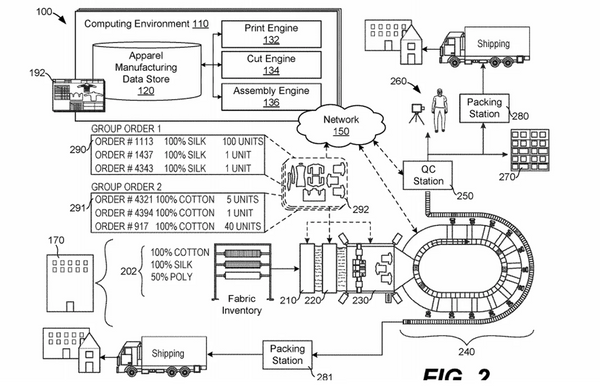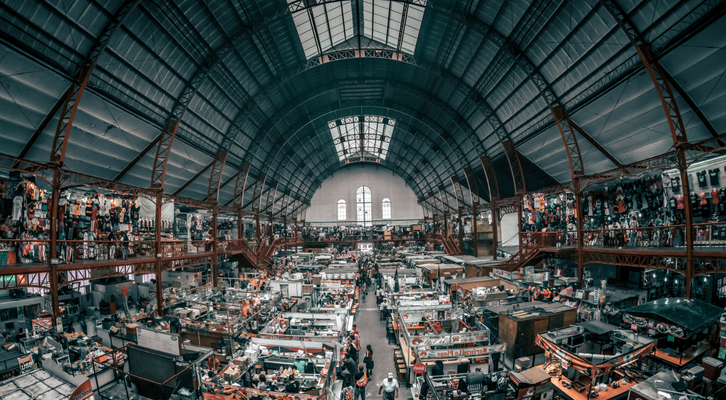Today, we live in an increasingly on-demand world. We watch TV shows and movies on-demand through various streaming services, we rent a car through Zipcar, and we hail a taxi (or Lyft) on-demand.
With these changes, many companies aspire to become the on-demand version of the product or service they’re bringing to the market (groceries delivered on-demand, anyone?). A similar transformation is happening in the manufacturing industry.
With the rise of technology and a shift in the way new products are introduced to the market, crowdfunding sites like Kickstarter can help connect retailers with buyers — opening the door for new ideas to come to life without the need for a major upfront investment. This new approach to launching and selling products has ignited the need for better and faster production alternatives for retail businesses. One such option is on-demand manufacturing.
To help you decide whether on-demand manufacturing is right for your retail business, let’s take a deeper look at on-demand manufacturing and its benefits.
What is On-Demand Manufacturing?
On-demand manufacturing is advantageous for small businesses because of its low minimum order requirements. Low minimum order quantities (or MOQs) make inventory management more sustainable for retailers and small businesses.
On-demand manufacturing also allows retailers to test the market before doubling down on inventory for a particular product, which can help eliminate markdowns and avoid brand dilution.
The Challenges of Traditional Manufacturing Models
Before we dig into more details about on-demand manufacturing, it's beneficial to understand the traditional manufacturing supply chain that it replaces. The traditional manufacturing supply chain was built to support the demands of large businesses. Businesses and their product developers deal with manufacturers mostly by email and production facilities are located overseas. There are high minimum order requirements (or penalties for ordering less than the MOQ) and lead times are long.
With traditional supply chain manufacturing, the time it takes to create a product — from design to delivery — is roughly six to 10 months. If the product is produced overseas, you can expect the process to take closer to 10 months.
And because of the high MOQ of traditional supply chains, many retail businesses end up over-producing products. Over-production of inventory results in excess stock at the end of the season, markdowns, and a negative impact on the retailer’s margin. Not to mention it isn’t great for the environment.
By using an on-demand manufacturing process, retailers can avoid the obstacles mentioned above.
Manufacturing on-demand means retailers never have to warehouse inventory. You can avoid getting stuck with excess inventory at the end of the season by manufacturing only the products that customers order. You also don’t deal with high minimum order requirements. This eliminates the need to markdown products to sell off stale inventory, reduces over-production of finished products, and cuts back on wasted materials.
The right on-demand manufacturing system also allows retailers to increase their speed to market. It's likely that orders can ship within one to 10 days after your customer places an order.

Ecommerce giant Amazon already employs this manufacturing model and is working to perfect it. The company recently won a patent for its on-demand clothing manufacturing warehouse.
"The goods will be manufactured in batches based on factors such as the customer shipping address," the patent reads.“By aggregating orders from various geographic locations and coordinating apparel assembly processes on a large scale, the embodiments provide new ways to increase efficiency in apparel manufacturing.”
While this patent is designed for clothing, the inventors believe this system could work for other categories and materials, including paper, plastic, leather, and rubber.
The Advantages Of On-Demand Manufacturing
 A recent article in the Sourcing Journal states: "The win with on-demand is two-fold: the customer gets exactly what they want, and the brand only has to make exactly what they want. That means little waste, no excess inventory, and no accounts receivable risk."
A recent article in the Sourcing Journal states: "The win with on-demand is two-fold: the customer gets exactly what they want, and the brand only has to make exactly what they want. That means little waste, no excess inventory, and no accounts receivable risk."
There are a number of benefits to the on-demand manufacturing approach that makes it a more sustainable manufacturing option for retailers, including:
1. No Markdowns
Markdowns occur at the end of the season when a retailer still has stock of a particular style, color, or size that hasn’t sold and is no longer applicable for the next season. Rather than continuing to warehouse the inventory or keep it on the selling floor, many retailers offer discounts and promotions to sell through their inventory.
If you use on-demand manufacturing, you eliminate the risk of having to markdown or discount products at the end of your selling season, which is especially helpful if you employe a no-discount strategy. You only have to manufacture what your customers order — which is more efficient and helps you save money.
2. Eliminate Waste
Manufacturing only what your customers order not only eliminates the need to discount excess inventory, but it also eliminates leftover materials.
Unfortunately, not every product is a "crowd pleaser" and manufacturing on-demand means you don't have to make something before you know if it will sell. And less waste means more space in your warehouse and in your stores for popular products.
3. Quick Turnaround
The traditional manufacturing supply chain has lead times ranging from six to 10 months, depending on the product a retailer is making and whether you're manufacturing domestically or overseas. While it is reliant on the facility and the product, on-demand manufacturing offers lead times of one to 10 days from the moment your customer places the order.
4. Market Testing: React to Your Customers
Test your product and find your product-market fit before you spend more money on your idea. Having no minimum order requirement means you can make one piece at a time. Create one product, list it on your website, show your friends, gauge interest, and then decide if it's worth investing more time and money into your idea.
5. Seamless Proto Sampling
Traditional manufacturers either charge exorbitant fees for proto sampling or they don't offer sampling services at all. Many on-demand services take the headache out of sampling, making it accessible for retailers that are launching a new product.
6. Easier Inventory Management
Many on-demand manufacturing companies provide support through the entire product lifecycle by acting as the warehouse and inventory management service for your finished products.
If you choose to make a limited quantity of inventory upfront, this can eliminate the time and costs of shipping products from your manufacturer to your warehouse. Shipping orders directly from the manufacturer can mean faster shipping times, which often makes for happier, more loyal customers.
7. No Minimum Order Quantity (or MOQ)
Whether you’re making your first sample or fulfilling an order of 100 units, on-demand manufacturers can meet your order requirements quickly.
As your business grows and your needs change, you can continue to manufacture with the same facility as you scale. On-demand manufacturing requires no MOQ so you never have to order more than you can afford or need at any given time.
8. Better Cash Flow
Get your money out of your inventory and improve your cash flow. Free up valuable dollars to spend on sales and marketing efforts that will help you increase sales revenue and ultimately grow your business.
When compared to manufacturing product in bulk, manufacturing on-demand may result in a higher cost price per unit. But, the advantage is that you have consistent margins and know exactly what your profit will be for each unit sold. You don't risk getting stuck with the end of the season inventory that you have to markdown or absorb.
For example, if you sell a top for $50 retail and it cost you $25 to make (COGS), your retail margin for one unit is 50% or $25 gross profit per unit.
- $50 (retail price) - $25 (COGS) / $50 (retail price) = 50% (retail margin)
- $50 (retail price) - $25 (COGS) = $25 (gross profit per unit)
If you have to mark down the same top at the end of the season, by 30%, you will dilute your gross profit and retail margin.
- $50 (original retail price) X .30 (30% discount) = $15 (discount)
- $50 (original retail price) - $15 (discount) = $35 (retail after discount)
- $35 (retail after discount) - $25 (COGS) / $35 (retail after discount) = 29% (retail margin after discount)
- $35 (retail after discount) - $25 (COGS) = $10 (gross profit per unit after discount)
Based on the example above, if you choose on-demand manufacturing, you know your margin will always be 50% — rather than taking the risk of almost cutting your margin in half, to 29%.
Please note, these values are placeholders to show calculations. They are not necessarily representative of retail margins that you should aim for.
9. Sourcing and Material Management
Many on-demand manufacturers offer full-service packages including sourcing and ordering materials, inventory management, and handling inbound shipments of other items needed to produce your products. In some cases, on-demand manufacturers also offer design services.
10. Order Fulfillment and Shipping
The final step in the product lifecycle is shipping a purchased product to your customers — on-demand manufacturers can take care of that for you as well.
On-demand manufacturers usually have an API that integrates with your ecommerce store to ensure that as soon as a customer places an order it is prioritized for production. Once the product is made, it's picked, packed, and shipped from the same facility.
When Does On-Demand Manufacturing Work Best?
Many retailers have a core (or basic) collection that is available all year long — AKA your "bread and butter." Seasonal or capsule collections are developed and dropped in to refresh a brand’s offering and increase sales revenue. This is where on-demand plays an integral role in your supply chain.
Seasonal collections — particularly for apparel and accessories brands — capture the trend of the moment and are not as long-lived as essential pieces a brand offers year round. Sometimes seasonal collections can also be a total dud, which can result in markdowns, waste, and brand dilution.
An article in The Business of Fashion states, "Traditionally, retailers prefer to hold off on markdowns until later in the year, as discounting too early and too deeply can shrink already squeezed profit margins. Sometimes, it can also cheapen the perception around a brand or retailer."
Designing and manufacturing seasonal collections on-demand allows brands to test a product before they buy into it. They only need to make a few units to test the market, try selling in-store, or create samples to photograph for their ecommerce store.
If there’s a spike in sales for a specific style, the brand can decide, based on demand, if they'd like to produce more and absorb the units into their inventory. Or, they can play it safe and continue to produce their customer orders on-demand.
The on-demand manufacturing model completely eliminates the risk of overproducing and underselling — making it possible for small business, entrepreneurs, Kickstarters, and makers to create and test new products with very little upfront financial commitment and risk.
Moving Forward With On-Demand Manufacturing
Now that you understand the on-demand manufacturing model, you can make a more informed choice on whether it makes sense for your business.
Read more
- Inventory Accuracy: How to Identify & Solve Discrepancies in Stock Levels
- The Complete Guide to Purchasing Product Samples
- Inventory Reporting 101: A Retailer's Guide to Reporting on Inventory
- Keeping Up With Demand: Tactics to Boost Productivity And Get Orders Out on Time
- What is Overselling (+ How to Prevent It)
- Diversify Your Offerings: Takeaways From 5 Service-Based Businesses Turned Retailers
- 8 Benefits Of Outsourcing Order Fulfillment for Your Retail Business
- The Retailer’s Guide to the Weighted Average Cost Method





